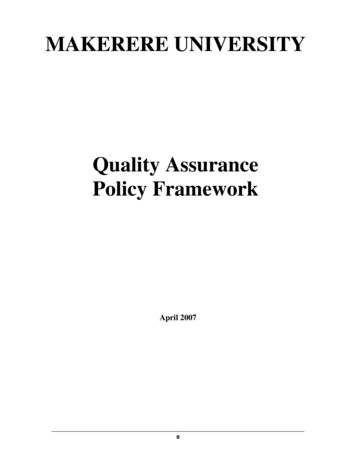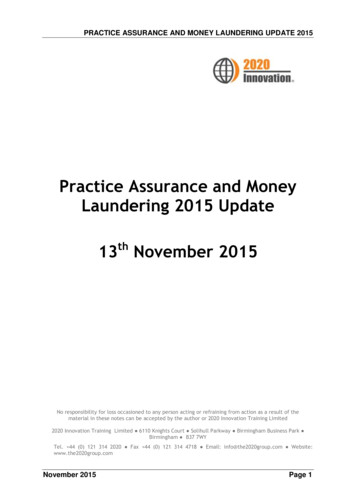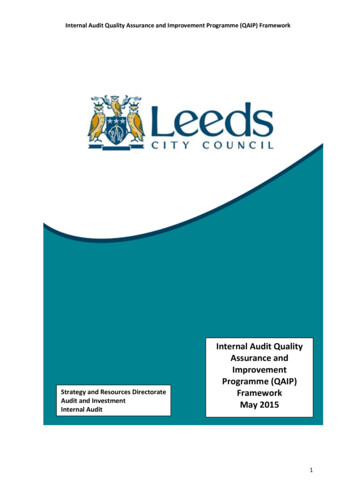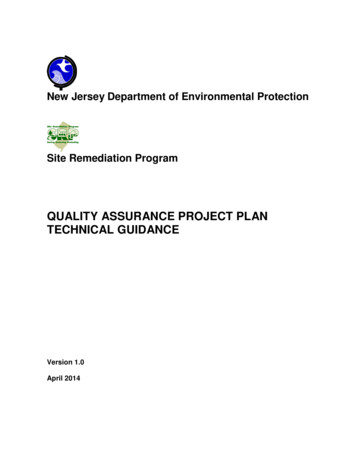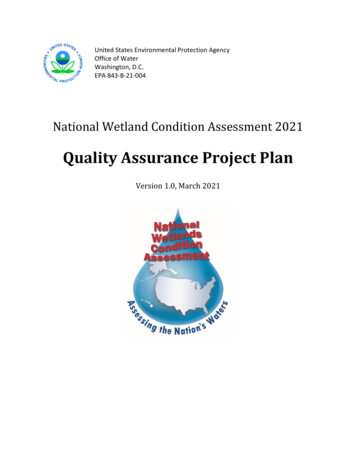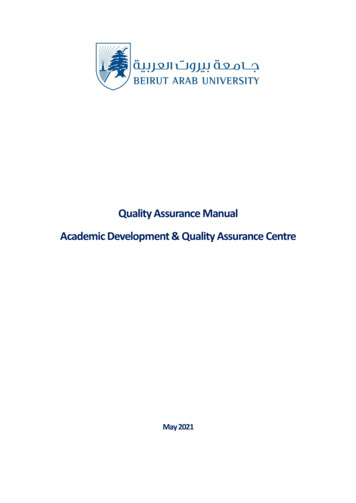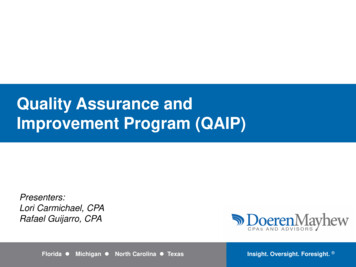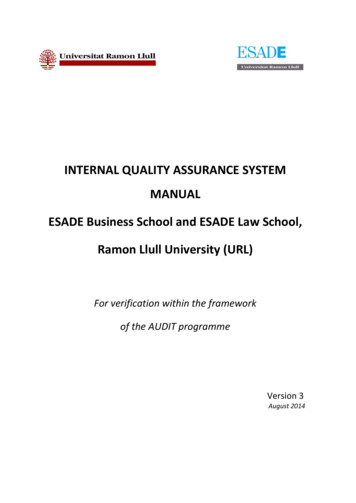
Transcription
INTERNAL QUALITY ASSURANCE SYSTEMMANUALESADE Business School and ESADE Law School,Ramon Llull University (URL)For verification within the frameworkof the AUDIT programmeVersion 3August 2014
Internal Quality Assurance System ManualVersion reviewed by the Vice-Dean of ESADE Programmes and Education Innovation and approved in accordance with procedure ESADE D0 01 by Executive Committee (CEX) on May 2014Change historyVersionnumberDateAuthorReason for the change115/2/2008Quality Assurance AreaFirst Draft1.111/4/2008Quality Assurance AreaUpdating of the Curriculum Committee Process1.21/9/2011Quality Assurance AreaReview of Procedures225/3/2014Quality Assurance AreaNew version with changes in all thedirectives, and the inclusion of newDirective 02.115/4/2014Quality Assurance AreaChange of name of various chapters2.25/5/2014Quality Assurance AreaChange table of processes2.328/8/2014Quality Assurance AreaCorrections of writingInternal Quality Assurance Manual2
CONTENTSAUDIT PROGRAMME. - 6 PRESENTATION OF CENTRE . - 6 Name of Centre: ESADE . - 6 Official degrees awarded by the centre . - 6 Headquarters . - 6 Address . - 6 Responsible for Quality Assurance System (SGIQ) . - 6 Flow Chart . 7Directive 0: General aspects concerning the Internal Quality Assurance System (SGIQ) .8a) Process map with an unambiguous relationship between the processes in which the SGIQ isstructured and the AUDIT programme’s guidelines. . 8b) Details of those responsible for each process . 9c) Scorecard of indicators for the SGIQ or specific to each Directive/process . 10d) How SGIQ documentation is managed . 11e) How overall review of SGIQ is carried out and improvements made . 11Directive 1: How ESADE defines its QA policy and objectives regarding education . 12a) Guidance framework for ESADE’s Quality Policy and Objectives . 12b) Body in charge of the education quality policy and objectives . 12c) Stakeholders targeted by QA Policy and Objectives . 12d) Defining, approving and implementing Quality Policy and Objectives . 13e) How information for reviewing education quality policy and objectives is gathered and analysed . 14f) Implementation of improvements stemming from review of the Quality Policy and Objectives . 14g) Reference frameworks . 14h) Directive Processe . 15Directive 2: How ESADE ensures the quality of its programmes . 16a) The persons and bodies responsible for programmes . 16b) Stakeholders . 17c) Process of defining, approving and implementing programmes . 18d) How information is gathered and analysed in the review for improving programmes . 18e) Implementation of improvements arising from review of programmes . 21f) Criteria for discard a programme . 21Internal Quality Assurance Manual3
g) Reference frameworks . 21h) Directive processes . 22Directive 3: How ESADE develops its programmes to foster student learning . 23a) The organs responsible for developing measures covering programmes . 23b) Stakeholder groups . 23c) How ESADE defines, approves and implements the aforementioned measures . 24d) How information for the aforementioned improvement-oriented reviews is gathered and analysed24e) How improvements arising from the review of the aforementioned measures are implemented . 24f) How processes bearing on education programmes are carried out . 25g) Reference frameworks . 25h) Directive processes . 25Directive 4: How ESADE ensures and improves the quality of its faculty and its administration and servicestaff 26a) The bodies responsible for personnel policy . 26b) Stakeholders . 28c) How the personnel policy is defined and is implemented in the light of staff needs . 28d) How staff access, training, evaluation, promotion and recognition are defined, approved andimplemented . 29e) How information is gathered and analysed for the review and how improvements are implemented inthe aforementioned processes . 30f) Reference frameworks . 31g) Directive processes . 31Directive 5. How ESADE ensures the quality of its material resources and services. 32a) Bodies (structure, functions and decision-making) in charge of material resources and services . 32b) Material resources and services — stakeholders . 33c) How material resources and services are designed and managed . 34d) How information for improving material resources and services is gathered and analysed . 34e) How improvements arising from the review of material resources and services are implemented . 34f) Reference frameworks . 34g) Directive processes . 35Directive 6. How ESADE gathers and analyses the results of the measures taken for improving itsprogrammes . 36a) The bodies responsible for gathering and analysing the results of programmes (that is, learning,placement and student satisfaction results) . 36b) Stakeholders . 36c) How training programme results are gathered and analysed . 36d) How training programme improvements are implemented . 36e) How the reliability and representativeness of training programme results are ensured. 37Internal Quality Assurance Manual4
f) Reference frameworks . 37g) Directive processes . 37Directive 7. How ESADE publishes information on its programmes and renders account . 38a) Bodies responsible for publishing information and rendering account . 38b) Stakeholders in the publication of key information . 39c) How and when information is given and how account is rendered with regard to: . 40d) How information on programmes and related matters is reviewed, updated, made accessible andaccount rendered . 41e) How improvements are implemented (these arise from: programme review and updating; checks oninformation objectivity and accessibility; rendering of accounts). 41f) Reference frameworks . 41g) Directive processes . 41Appendix – Processes linked to the SGIQ manual . 42Internal Quality Assurance Manual5
AUDIT PROGRAMMEESADE has had an Internal Quality Assurance System Manual (QASM) in place since the firstedition of the AUDIT programme during the academic year 2007/2008.After this call, there have produced external changes in the centre with regards to the directivesof the Manual as well as internal organizational changes adapting to the needs of stakeholders.Moreover, the own experience in the process applications of the Manual since its start has suggested the incorporation of operative improvements, in general focused towards an administrative simplification.These reasons have led us to check the manual in the present second version of the manual,which has been approved by all responsible organs of the programme, including the processesassigned to the different directives.PRESENTATION OF CENTREName of Centre: ESADE-Business School-Law SchoolOfficial degrees awarded by the centreThe current official degrees offered by the Ramon Llull University can be found on the university’s official webpage AddressAv. Pedralbes 60-6208034 BarcelonaResponsible for Quality Assurance System (SGIQ)-Dr. Alfons Sauquet, Dean of the Business School-Dr. Eduardo Berché, Dean of the Law SchoolInternal Quality Assurance Manual6
Flow ChartBoard of trusteesESADE’sFoundationDirector rateDeputy DirectorGeneralSecretary GeneralBrand &CommunicationEconomic &FinanceManagementHumanResourcesDean,Business tamentsEstrategicUnitsAdmissionsPhD & Masterof ResearchAcademicServicesDean,Law SchoolCareerServicesVice-Dean ofProgrammes &EducationalInnovationVicedeanLaw SchoolFurtherTraining andPostgradsUniversityDegrees andMastersDoctoratesVice-Dean of emicDepartmentsAdmissionsInternal Quality Assurance Manual7
Directive 0 - General aspects of the Internal Quality Assurance SystemDirective 0: General aspects concerning the Internal QualityAssurance System (SGIQ)a) Process map with an unambiguous relationship between the processes in whichthe SGIQ is structured and the AUDIT programme’s guidelines.Below you can find the processes map of ESADE which corresponds to the needs ofstakeholders. On the other hand, they are giving continuity to the processes established by theVice-Rectorate of Academic Policies of the URL (which list in each directive and in the appendixof the manual).INNOVATIONPE1DEFINING QUALITY POLICYPC1SGIQ IMPLEMENTATION INPROGRAMMESPS1PUBLIC INFO & RENDERING OF ACCOUNTInternal Quality Assurance ManualPE2CREATION & REVIEW OFPROGRAMMESPC2TEACHINGPLANNINGPE3DEFINING POLICY FOR FACULTY & ADMIN C4STUDENTASSESSMENTPS3FACULTY & ADMINSTAFF ASSESSMENT8
Directive 0 - General aspects of the Internal Quality Assurance Systemb) Details of those responsible for each processSGIQ ProcessesResponsibleDirectiveCodeSGIQSTRATEGIC PROCESSESPE1Definition of the Quality and SGIQmanual policyPE2Creation of programmesPE3Definition of PDI / PAS policyMonitoring, review and improvement of ESADE’s SGIQ processesDefinition of policies and quality objectivesApproval and revision of programme processesDefinition of faculty policiesRecruitment and selection of teachersExecutive Committee/ Academic BoardsExecutive Committee/ Academic BoardsDeanFaculty DeanFaculty Dean0ESADE D0 011ESADE D1 01244ESADE D2 01ESADE D4 01ESADE D4 03Programme ManagementProgramme ManagementProgramme Management333ESADE D3 01ESADE D3 02ESADE D3 05Programme Management2ESADE D2 02Programme ManagementInternal Quality AssuranceManagementProgramme ManagementProgramme ManagementProgramme Management2ESADE D2 033ESADE D3 03336ESADE D3 06ESADE D3 04ESADE D6 01Programme Director7ESADE D7 01Programme Director5ESADE D5 01Programme Director6ESADE D6 01Faculty Dean4ESADE D4 02Faculty Dean4ESADE D4 04KEY PROCESSESPC1SGIQ implementation in educationprogrammesPC2Review, monitoring and accreditation of qualificationsAdmissions processStudent mobility processClaims processProcess for the development of programme monitoring reports(IST)Programme Accreditation processProgramme Audit processPC3Student guidance and supportPC4Student evaluationsSUPPORT PROCESSESPS1Public information and reportingPS2PS3Academic organisationPDI / PAS EvaluationInternal Quality Assurance ManualTutoring processCareer Services processGathering of information and results - SurveysPublication of information and accountability processesAnalysis and implementation of requirement related to materialresources and servicesGathering of information and results - SurveysEvaluation of the contribution, promotion and recognition of thefacultyFaculty training processes9
Directive 0 - General aspects of the Internal Quality Assurance Systemc) Scorecard of indicators for the SGIQ or specific to each Directive/processThe Annual Reports on each Programme (IST) include indicators established by the Universityin accordance with AQU guidelines. If they see fit, Vice-Deans and Programme Directors mayadd further indicators for decision-making on a given programme.DIRECTIVESGeneral aspects of the Internal Quali0ty Assurance SystemHow the school defines its own quali1 ty policy and objectives regardingeducation.2INDICATORSSGIQ approved by AQU and URLReview of Quality Assurance policy in the Strategic PlanHow the school assures the quality of The Programme Report has been approved byits education programmes.the Curriculum Committee and the AQUSelectivity: demand/ admissionsYield: admissions/entrants34567% international studentsHow the school is developing its education programmes to foster student Nº nationalities in the programmelearning.Percentage of students in the cohort passingexternal internshipsPercentage of student taking part in overseasexchangesHow the school assures the quality of % faculty with PhDsfaculty and administrative and serviceNº of papers in high-impact publicationsstaff.How the school centre assures theFaculty satisfaction with Services and Infrastrucquality of resources and materialsture in the Teaching Experience Survey (1-7)Performance rateDrop-out rate (%)Graduation rate (in t or t 1, t: duration of programme)Efficiency rate in t or t 1Average length of studiesHow the school gathers and analysesStudent satisfaction with the programme (scaleresults to improve its programmes.1-7)Graduates’ satisfaction with the training received(scale 1-7)Faculty satisfaction with the programme (scale1-7)Employment rateThe information set out in the first chapter of ISTHow the school publishes information is made public in the ESADE website.and reports on its programmes.The ISTs are submitted to the Programme Academic Boards (JA).Internal Quality Assurance Manual10
Directive 0 - General aspects of the Internal Quality Assurance Systemd) How SGIQ documentation is managedThe Quality Assurance Area manages the documentation covering the SGIQ: SGIQ documentation comprises the Manual and Procedures. This documentation is publicly available to all stakeholders through the ESADEwebsite. Those in charge of programmes have Intranet access to documents coveringactivities planned for Quality Assurance processes (acts, reports and so on).Regarding the coding of documents included in the manual, in order to facilate understandingand adapt to the new strucutre of the manual, the exisiting process, the EGPCP0110 Procedurefor the Emision and Authorization of Documents, was modified and has been established in theform of recommendations within the review process of the manual.The nomenclature of the processes included in this manual consists of three sections: ESADE, to differenciate the documents issued and approved from the Rector of theURL regarding documentation issued and approved by the processes of ESADE. Dx, coding of the specific guidline specifies in which the process is referred to. Xx, the number of the process within the guidline. The version of the document will beincluded in the template itself.Thus, and to illustrate the process regarding the monotoring, review and improvement ofESADE’s SGIQ manual, guidline 0 will have the following code: ESADE D0 01The revision of the documentations is related to the revision of the manual itself, so that byfollowing the process ESADE D0 01, there will be a regular revision and update, if necessary,of the manual and the processes connected to it.e) How overall review of SGIQ is carried out and improvements madeThe Internal Quality Assurance System manual was drawn up by ESADE in the light of bothAUDIT programme requirements and has obtained a favourable assessment from AQU .Substantial changes to the manual should be proposed by the Quality Assurance Area andapproved by ESADE’s Executive Committee and by the Academic Boards for each programmeand subsequently submitted to Ramon Llull University’s (URL) Vice-Dean’s Office for itsapproval.Every two years, the Quality Assurance Area draws up an SGIQ monitoring report, which issubmitted to the URL’s Vice-Dean Office.Internal Quality Assurance Manual11
Directive 1 - How ESADE draws up its training QA policy and aimsDirective 1: How ESADE defines its QA policy and objectivesregarding educationa) Guidance framework for ESADE’s Quality Policy and ObjectivesThe texts describing ESADE’s purposes and modus operandi are approved by the ESADE Foundation and are published in ESADE’s official web site in the document: Mission, values andteaching orientation. This document explains the values stated by ESADE in defining and developing its functions and activities. Among other things, it mentions academic and professional skills, improvement and innovation, and social responsibility. These values inspire andform part of ESADE’s Quality Policy.ESADE’s culture of quality is the fruit of a track record of drawing up policies, strategies andmeasures for improving the quality of its degrees, teaching activities, research and management. The strength of ESADE’s commitment to quality assurance can be seen in the fact that itwas the first business school in Spain and one of the first in Europe to obtain the three mostrecognized business study accreditations (AMBA since 1994, EQUIS since 1998, AACSB since2001).b) Body in charge of the education quality policy and objectivesFunctions:The Executive Committee (CEX) is the body defining and approving Quality Assurance (QA)processes with a view to implementing, monitoring and improving them in each degree. Its QAdecisions are debated and approved, as the case may be, by the Academic Boards (JA).The CEX and Academic Boards’ task regarding QA processes are: Defining and verifying QA policies and objectives Ratification of the SGIQ manual and substantial manual amendmentsDecision-making:The CEX approves documents submitted for its consideration and takes other decisions it considers appropriate regarding of QA. Such decisions must require an absolute majority of allmembers, whether present or absent. The Chairman may cast his vote to break a tie.c) Stakeholders targeted by QA Policy and ObjectivesThose involved in establishing, monitoring and reviewing ESADE’s QA Policy and Objectives: Management, deans, directors of strategic units, programme directors, as those incharge of organising programmes Faculty, as those directly in charge of imparting training Administrative and Service Staff (PAS), providing training supportInternal Quality Assurance Manual12
Directive 1 - How ESADE draws up its training QA policy and aims Students, who take part in and benefit from training Alumni / Empoyers, involved in continuous improvement of trainingd) Defining, approving and implementing Quality Policy and ObjectivesCEX is in charge of defining ESADE’s academic Quality Policy. The proposal is drawn up andsubmitted by the Vice-Dean of Education Programmes and Innovation. Among other things,the proposal must ensure that:-Quality and Quality Assurance are key values guiding institutional measures;-Quality Policy covers all ESADE’s education programmes;-Quality Assurance procedures provide a framework for stakeholders to examine,reflect on and improve teaching and learning activities;-Quality Policy is based on responsibility, transparency, participation and continuousimprovement.The formulation of Quality Policy and Objectives must be aligned with the mission, vision andvalues mentioned in Section (a) of this Directive.Application of the quality objectives is linked to the content of the institution’s Strategic Planwith regard to quality improvements to academic/teaching and to innovation in learningprocesses.Implementation of quality policy and objectives is assigned to the Vice-Dean of EducationProgrammes and Innovation and basically consists of:-Reviewing and updating the Internal Quality Assurance System Manual.-Co-ordinating implementation of the procedures set out in the SGIQ Manual by SGIQmanagers.Those mainly in charge of the various procedures are:-Directors of strategic units and programme directors (PD), with regard to the chain ofeducation activities underpinning each programme (syllabus, admission, teaching,exchange programmes, learning and professional guidance, etc.).-Vice-Dean of Faculty and departmental directors, with regard to managing faculty.-Vice-Dean of Education Programmes and Innovation, with regard to co-ordination andsupport of activities in the Quality Assurance sphere.Internal Quality Assurance Manual13
Directive 1 - How ESADE draws up its training QA policy and aimse) How information for reviewing education quality policy and objectives is gatheredand analysedAt the end of each academic year, the Quality Assurance Area gathers the results of the various QA activities and processes and draws up an Annual Report. Its contents take into accountthe various QA tools used — especially those bearing on both home and foreign external QAagencies — as well as internal ones employed by URL and ESADE. It also includes analysis ofproposed objectives and recommendation for improvements.Information-gathering is based on: (1) QA agencies assessment reports; (2) annual reportsdrawn up by directors for the respective programmes; (3) the results of student and facultysurveys; (4) the information available to vice-deans; (5) information generated by the QualityAssurance Area.f) Implementation of improvements stemming from review of the Quality Policy andObjectivesThe first step is to publicise the decisions taken — something that is facilitated by the make-upof the CEX and the Academic Boards, which include stakeholder representatives and/ormanagers.The SGIQ manual in force is subsequently published on the ESADE website. The QualityAssurance Area makes decisions known to those persons or groups responsible for theirimplementation.The approved changes are made in each area as required. The Vice-Dean of ProgrammesEducational Innovation monitors operational implementation and deadlines.g) Reference frameworksThe reference frameworks for defining ESADE’s Quality Policy and Objectives are as follows: ESADE’s mission, values, and teaching orientation ESADE’s Strategic Plan and strategic priorities URL’s mission URL’s Quality Policy URL’s Strategic Plan and strategic priorities The criteria, directives, and quality standards of the European Higher Education Area,AQU and international accreditation agencies (AACSB, EQUIS, AMBA)Internal Quality Assurance Manual14
Directive 1 - How ESADE draws up its training QA policy and aimsh) Directive ProcesseThe processes established in the Vice- Rectorate of the URL are: MSGIQ-URL-FT-D1/01: Process of definition of the transversal policy and quality objectives of the URLThose which correspond to ESADE: ESADE D1 01: Definition of policies and quality objectives.Internal Quality Assurance Manual15
Directive 3 - How ESADE develops its training programmes to foster student learningDirective 2: How ESADE ensures the quality of its programmesa) The persons and bodies responsible for programmesStructure:Programme DirectorA Programme Director is in charge of each degree. He is the academic in charge and amongother things, is responsible for: general co-ordination; planning, development and supervisionof teaching. In performing these duties, he keeps in close contact with faculty and their respective heads of department, and students. He takes account of the recommendations of all thoseinvolved in the learning process, the requirements of the SGIQ and the content of the approved Programme Report.Strategic Activity UnitIn organisational terms, each programme falls under a Strategic Activity Unit (UEA). ESADEBusiness School’s current UEAs are: University Programmes (BBA and Masters programme forthose lacking work experience), MBA, and Executive Education (EMBA programmes, URL Masters programmes, Post-Graduate programmes). The whole of the Law School constitutes anUEA. The Vice-Dean of Research is in charge of Research Masters programmes and doctorates.Curriculum CommitteeThis is the academic body that evaluates and -where appropriate- approves the report proposal for new programmes or substantial changes to existing ones. Among the aspects it takesinto account are: defining learning objectives; the syllabus; contents; teaching methods; teaching resources; evaluation and improvement of the degree. The Committee’s approval is required to launch any new programme or to make substantial changes to existing ones and forprocessing the administrative submission to the URL’s Vice-Rector’s Office and to the corresponding university agencies and authorities. The Committee’s composition and functions areset out in Procedure ESADE D2 01.Functions: Analysis and approval of the Report proposal requesting new programmesAnalysis and approval of proposals for making substantial changes to existing programmesProgrammes requiring the approval of the Curriculum Committee are: official universitydegrees, URL own degrees and ESADE programmes lasting over 200 hours.Internal Quality Assurance Manual16
Directive 3 - How ESADE develops its training programmes to foster student learningCompositionPermanent members: Vice-Dean of Programmes and Education Innovation, who acts as ChairmanDirector of the Strategic Activity Unit (UEA)Director of the Quality Assurance AreaDirector of the corresponding Department (in programmes of a functional nature)The Director of the corresponding Centre/Institute/Chair (in programmes of a sectorial nature) Programme Direct
1.1 11/4/2008 Quality Assurance Area Updating of the Curriculum Commit-tee Process 1.2 1/9/2011 Quality Assurance Area Review of Procedures 2 25/3/2014 Quality Assurance Area New version with changes in all the directives, and the inclusion of new Directive 0 2.1 15/4/2014 Quality Assurance Area Change of name of various chapters
